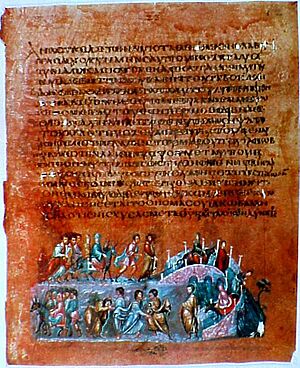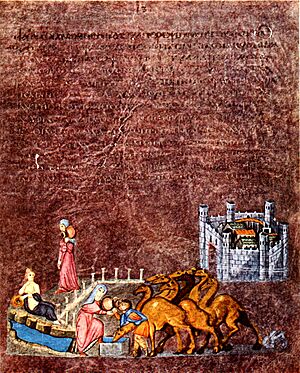Vienna Genesis facts for kids


The Vienna Genesis is a very old and special book. It is kept in Vienna, Austria, at the National Library. This book is an illuminated manuscript, which means it's a handwritten book with beautiful pictures. It was probably made in Syria around the early 500s.
It is one of the oldest illustrated Bible books still around today. Only the Garima Gospels from Ethiopia are as old or even older. The Vienna Genesis contains parts of the Book of Genesis from the Greek Septuagint Bible translation. The stories in the book are sometimes shortened.
The book has twenty-four pages, called folios, that have survived. Each page has small pictures at the bottom of both sides. Experts believe the book originally had about ninety-six pages and 192 pictures! The text is written in a special old style of writing called uncials. The words are written with silver ink on vellum, which is a type of treated animal skin. The pages are also dyed a rich purple color. This purple color was very expensive and was often used for royal clothes. This shows that the Vienna Genesis was a very fancy and important book.
The Vienna Genesis is similar to other old books like the Rossano Gospels and the Sinope Gospels. These books were made around the same time.
Contents
Amazing Pictures and Stories
The pictures in the Vienna Genesis are drawn in a natural style, typical of art from the Late Antique period. The way the pictures are shown is a mix between older scroll art and newer book art. Each picture is painted at the bottom of a page.
What's really cool is that one picture can show more than one part of a story! So, the same person might appear a few times in one picture to show what they did next. Some pictures have frames around them, and some do not. The pictures sometimes include things or people that are not mentioned in the Bible's Genesis text. These extra details might come from popular versions of the stories or from old Jewish writings about the Bible.
Rebecca and Eliezer at the Well
One famous picture shows Rebecca and Eliezer at the Well. This picture tells the story from Genesis chapter 24. In this story, Abraham's helper, Eliezer, goes to find a wife for Abraham's son, Isaac. Eliezer travels with ten camels. He stops to give them water and prays that Isaac's future wife will help him water his camels. Then, Rebecca appears and helps Eliezer.
Rebecca is shown twice in the picture to tell the whole story. She wears a pink dress. First, you see her walking from a city in the background, carrying a water jug on her shoulder. She is walking towards a body of water. Next to the water, there's a female figure that looks like an old Greek or Roman goddess, representing the spring or well. Then, Rebecca is shown a second time at the well, helping Eliezer.
Jacob Wrestling The Angel
Another picture shows Jacob Wrestling The Angel. This scene is from Genesis chapter 32. It shows Jacob wrestling with an angel all night long. In the picture, Jacob is holding onto the angel's cloak. The angel is reaching out to touch him. Like the Rebecca picture, the figures are shown from the side. They have long bodies and faces with strong expressions.
The artists used gold and silver paint, and added many small details to the clothes and hair. This makes the picture look very rich and beautiful. The story shows Jacob, wearing a brown and reddish tunic. He wakes up and leads his family across a river. His wives are on donkeys, and many servants follow him. After crossing the river, Jacob meets an angel. He is then shown wrestling the angel. Finally, the angel blesses him. Jacob is shown many times in this picture to tell the whole story. Because of this story, Jacob is later blessed by God and renamed Israel. The bridge in the picture has Roman-style columns. This shows how old Roman art influenced the artists.
See also
- Early Christian art and architecture
- Cotton Genesis – another old Greek book of Genesis with pictures

